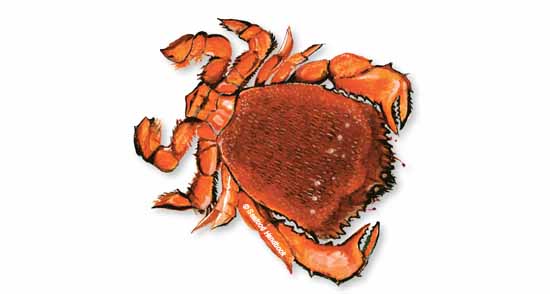Crab, Spanner
Published on
January 23, 2014

Spanner crab is a newcomer to the U.S. market, exported from northeastern Australia for the white-tablecloth-dining market. Because of its limited and recent distribution in this country, the crab does not yet appear on the USDA Fish List. Though Australian supplies dominate the domestic market, Hawaii also has a commercial fishery for the species, whose range extends through the Indo-Pacific region in sandy coastal waters. The odd-looking animal bears names reflecting its frog-like shape and large front pincers, which resemble spanners — or wrenches. Spanner crab is a good choice for buyers concerned about sustainability, as the selective harvesting method eliminates bycatch. In Australia, the crabs are trapped in baited net bags known as dillies. In Hawaii, where the species is called Kona crab or “Päpa’i kualoa,” fishermen employ flat, circular nets baited and laid along the seafloor. Australian spanners are available year-round except for a month beginning at the end of November, when they spawn. Most of the spanner crabs harvested Down Under are exported as live product. The remainder is cooked and sold locally.
Ranina ranina
Spanner crab
Spanner crab, frog crab, red frog crab, Kona crab
Crabe
Krabbe
Granchio
Kani
Cangrejo
Spanner crab is a newcomer to the U.S. market, exported from northeastern Australia for the white-tablecloth-dining market. Because of its limited and recent distribution in this country, the crab does not yet appear on the USDA Fish List. Though Australian supplies dominate the domestic market, Hawaii also has a commercial fishery for the species, whose range extends through the Indo-Pacific region in sandy coastal waters. The odd-looking animal bears names reflecting its frog-like shape and large front pincers, which resemble spanners — or wrenches. Spanner crab is a good choice for buyers concerned about sustainability, as the selective harvesting method eliminates bycatch. In Australia, the crabs are trapped in baited net bags known as dillies. In Hawaii, where the species is called Kona crab or “Päpa’i kualoa,” fishermen employ flat, circular nets baited and laid along the seafloor. Australian spanners are available year-round except for a month beginning at the end of November, when they spawn. Most of the spanner crabs harvested Down Under are exported as live product. The remainder is cooked and sold locally.
The spanner crab’s shell color ranges from burnt orange to brick red even when uncooked and turns a brighter orange after cooking. The raw flesh is translucent and becomes bright white when cooked. The meat is soft and moist, with a slightly sweet and delicate flavor.
| Calories: | 62.4 |
| Fat Calories: | 4.5 |
| Total Fat: | 0.5 g |
| Saturated Fat: | 0.14 g |
| Cholesterol: | 29 mg |
| Sodium: | 373 mg |
| Protein: | 15.1 g |
| Omega 3: | 0.84 g |
The most common way to cook whole spanner crab is boiling or steaming for 12 or 13 minutes. Afterward, immerse immediately in cold water to stop further cooking. The picked meat can be used in stir-fries, salads, sandwiches, or as an addition to pasta dishes and risottos. It also works well as a filling for ravioli and Asian-style dumplings or won tons.
Blue swimming crab, Crayfish, Spiny lobster
- Bake
- Boil
- Broil
- Fry
- Grill
- Pate
- Poach
- Saute
- Smoke
- Steam
Live
Fresh: Hand-picked meat
Australia, United States





